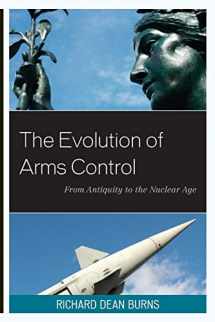
The Evolution of Arms Control: From Antiquity to the Nuclear Age (Weapons of Mass Destruction and Emerging Technologies)
ISBN-13:
9781442223790
ISBN-10:
1442223790
Edition:
Reprint
Author:
Richard Dean Burns
Publication date:
2013
Publisher:
Rowman & Littlefield Publishers
Format:
Paperback
264 pages
FREE US shipping
Book details
ISBN-13:
9781442223790
ISBN-10:
1442223790
Edition:
Reprint
Author:
Richard Dean Burns
Publication date:
2013
Publisher:
Rowman & Littlefield Publishers
Format:
Paperback
264 pages
Summary
The Evolution of Arms Control: From Antiquity to the Nuclear Age (Weapons of Mass Destruction and Emerging Technologies) (ISBN-13: 9781442223790 and ISBN-10: 1442223790), written by authors
Richard Dean Burns, was published by Rowman & Littlefield Publishers in 2013.
With an overall rating of 4.3 stars, it's a notable title among other
books. You can easily purchase or rent The Evolution of Arms Control: From Antiquity to the Nuclear Age (Weapons of Mass Destruction and Emerging Technologies) (Paperback) from BooksRun,
along with many other new and used
books
and textbooks.
And, if you're looking to sell your copy, our current buyback offer is $0.3.
Description
Drawing on his knowledge of the comparative history of warfare and arms control across preliterate, ancient, medieval, and modern polities, Richard Dean Burns focuses longitudinally on such perennial arms control issues as negotiation, verification, and compliance. Although he does not, for example, allege that war elephants and nuclear weapons are of equal destructive potential, he does discern instructive similarities between Carthage in 202 BCE and Iraq in 1991 AD. Arms control and disarmament measures have been pursued and adopted throughout the history and prehistory of human warfare: sometimes as protocols recognizing evolving humanitarian taboos; sometimes as terms imposed by the victors on the vanquished; and sometimes as accords negotiated between rivals fearful of mutual destruction. Arms control measures ramped up in significance and urgency at the dawn of the 20th century by the introduction of rapid-fire weapons, aircraft, chemical agents, and submarines, and again at mid-century with the advent of weapons of mass destruction—nuclear, chemical, and bacteriological—with sophisticated delivery systems. As Burns makes clear, the enormous increase in destructive potential brought about by thermonuclear weaponry essentially changed the nature of war and, therefore, of arms control.


We would LOVE it if you could help us and other readers by reviewing the book
Book review

Congratulations! We have received your book review.
{user}
{createdAt}
by {truncated_author}


